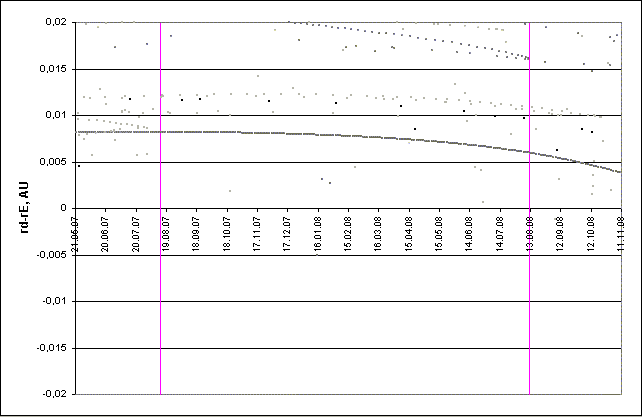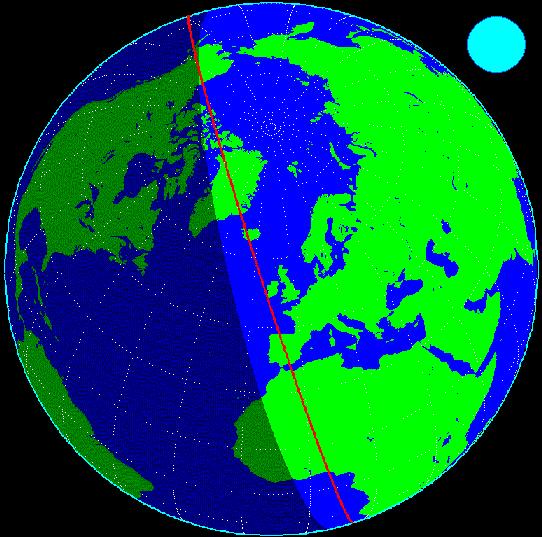Perseids 2007: prediction of activity
to the list of predictions
Introduction
Computation characteristics
We'd like to introduce the results of the Perseid meteor stream simulation aimed to the prediction of shower activity in 2007. The simulation was made for the trails of latest 7 revolutions, i.e, from the 1992 trail. The Author used the program by S. Shanov and S. Dubrovsky "Comet's Dust 2.0" to calculate orbital elements of ejected meteor particles. To estimate expected ZHRs for different encounters the model by E. Lyytinen and T. van Flandern given in their paper [4] was used with some Author's alterations made in order to adopt the model for ejection velocity (Vej) instead of da0 (difference in a-semimajor axis) and to convert the model from the Leonid stream (for which it was originally created) to the Perseids. The computation considered only gravitational forces, however, the results are on the whole in good accordance with these of other researchers. The prediction includes all encounters found within interval +/-0.007 a.u. The following parts of trails were computed: the first 5 rev. trails for ejection velocities [-50;100] m/s, 6-7 rev. trails - [-30;50] m/s.
Results
The Fig. 1 below shows the distribution of 109P dust trails in the vicinity of the Earth's orbit within the period of 11.05.2007 - 12.11.2008. The vertical axis shows the minimal distance between trails particles and the Earth's orbit. So far, the Fig. 1 displays the moments of passage of minimal distances to the Earth's orbit for various trails and particles and these distances themselves. The red vertical lines show the moments of passing by the Earth minimal distances to the (supposed) current orbit of 109P.
Introduction
Computation characteristics
We'd like to introduce the results of the Perseid meteor stream simulation aimed to the prediction of shower activity in 2007. The simulation was made for the trails of latest 7 revolutions, i.e, from the 1992 trail. The Author used the program by S. Shanov and S. Dubrovsky "Comet's Dust 2.0" to calculate orbital elements of ejected meteor particles. To estimate expected ZHRs for different encounters the model by E. Lyytinen and T. van Flandern given in their paper [4] was used with some Author's alterations made in order to adopt the model for ejection velocity (Vej) instead of da0 (difference in a-semimajor axis) and to convert the model from the Leonid stream (for which it was originally created) to the Perseids. The computation considered only gravitational forces, however, the results are on the whole in good accordance with these of other researchers. The prediction includes all encounters found within interval +/-0.007 a.u. The following parts of trails were computed: the first 5 rev. trails for ejection velocities [-50;100] m/s, 6-7 rev. trails - [-30;50] m/s.
Results
The Fig. 1 below shows the distribution of 109P dust trails in the vicinity of the Earth's orbit within the period of 11.05.2007 - 12.11.2008. The vertical axis shows the minimal distance between trails particles and the Earth's orbit. So far, the Fig. 1 displays the moments of passage of minimal distances to the Earth's orbit for various trails and particles and these distances themselves. The red vertical lines show the moments of passing by the Earth minimal distances to the (supposed) current orbit of 109P.

Fig. 1. Space-temporal projection of Perseid trails parts onto their minimal distance passages
In 2007 we do not expect the Earth to encounter young trails of the comet 109P. The stream structure in the vicinity of the Earth orbit will not be perturbed by Jupiter or Saturn, so we expect a normal Perseid maximum with ZHR of 90-100 meteors. IMO states, that in 2007 traditional maximum will occur at 5:30-7:00 UT on 13 August.
In 2008 in August the first particles from the stream part perturbed by Saturn will begin to pass by the Earth orbit. So far we expect a small increase of traditional peak - to 110-120 meteors on ZHR scale.
In 2008 in August the first particles from the stream part perturbed by Saturn will begin to pass by the Earth orbit. So far we expect a small increase of traditional peak - to 110-120 meteors on ZHR scale.

Fig. 2. The Earth as seen from coming Perseid meteors during the traditional maximum at 6:15 UT 13 August 2007. Red line shows the border of hemisphere where the Moon is above horizon (it is shown with light circle in the corner of the Fig. 2.).
The fig. 2 shows that Perseid maximum in 2007 will be seen from the North and South America. In the North America the radiant will be the higher the more to the east an observer is sutuated. The Moon will be close to new phase and won't make any troubles during observations.
On the other mainlands of the Northern hemisphere - Eurasia and Africa to the north of equator radiobservations are possible. The radiand will be the highest in the sky for observers in Europe and Northern Africa.
Conclusions
For Perseids in 2007 we expect a normal traditional maximum with ZHR not higher than 90-100 meteors. The most favorable conditions for observations of traditional maximum on August 13 at 5:30-7:00 UT will be in Northern America. The Moon close to new phase will leave the sky dark. In 2008 a small increase in shower intensity is possible - traditional maximum can reach 110-120 meteors on ZHR scale.
References
1. "Comet's dust 2.0" program by S. Shanov and S. Dubrovsky. [Used for orbital computations.]
2. Information from Gary W. Kronk's page http://www.maa.agleia.de
3. IMO Meteor Shower Calendar 2006 http://www.imo.net/calendar/russian/2006/spring.
4. Lyytinen E, van Flandern T. "Predicting the strength of Leonid outbursts", 2000, Icarus, P. 158-160.
On the other mainlands of the Northern hemisphere - Eurasia and Africa to the north of equator radiobservations are possible. The radiand will be the highest in the sky for observers in Europe and Northern Africa.
Conclusions
For Perseids in 2007 we expect a normal traditional maximum with ZHR not higher than 90-100 meteors. The most favorable conditions for observations of traditional maximum on August 13 at 5:30-7:00 UT will be in Northern America. The Moon close to new phase will leave the sky dark. In 2008 a small increase in shower intensity is possible - traditional maximum can reach 110-120 meteors on ZHR scale.
References
1. "Comet's dust 2.0" program by S. Shanov and S. Dubrovsky. [Used for orbital computations.]
2. Information from Gary W. Kronk's page http://www.maa.agleia.de
3. IMO Meteor Shower Calendar 2006 http://www.imo.net/calendar/russian/2006/spring.
4. Lyytinen E, van Flandern T. "Predicting the strength of Leonid outbursts", 2000, Icarus, P. 158-160.